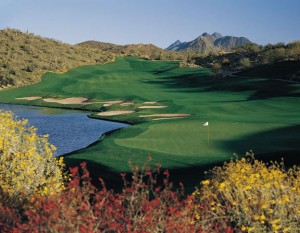Golf Club at Eagle Mountain Course Review
By Marina Beach • Oct 7th, 2015 Late September, early October is one of best times of the year to play golf in Arizona. The record-breaking temps start to subside, and golfers get to play the last of the immaculate fairways before courses overseed and raise green fees.
Late September, early October is one of best times of the year to play golf in Arizona. The record-breaking temps start to subside, and golfers get to play the last of the immaculate fairways before courses overseed and raise green fees.
The Golf Club at Eagle Mountain, located in Fountain Hills and settled amongst the southern foothills of the McDowell Mountains, provides a little bit of everything for all playing abilities. It is strategic enough for the more experienced, but yet not overpowering for beginners.
This traditional Scott Miller design traverses with a variety of land features from views of untouched desert and encompassing cacti to small arroyos and washes. One of my favorite features is the 300 feet of vertical elevation change between tee boxes and greens because it plays more mountainous versus links-style—an uncharacteristic find for metro Phoenix golf.
The par-4 seventh is one of the most scenic holes of the round. The elevated tee box overlooks the homes built into the hillside. Number seven also happens to be the most difficult hole on the front nine. Be aware of the bunkers short of the undulating green.
Another distinguishing feature, and something unique to Eagle Mountain, are the generous slopes that line and angle in toward the center of the fairways (think bowl-shaped). This design is perfect for all golfers, even the most experienced, because it keeps mishits in play rather than rolling yards into the dry, often-unsearchable desert.
One of my favorite holes demonstrating this design is the par-5, fourth hole. The second longest hole on the course actually sets you up for success. Aim toward the black and white stake off the tee and it will be smooth sailing in. However, if you happen to fade one right on one of your approach shots in, you should end up okay. The big hill on the right kicks balls back into play.
From the outside, Eagle Mountain looks more constrained compared to other desert courses due to the residential community, but it fortunately does not play that way. The houses never came into play, even on my couple of drives that happened to wander from the fairway.
 And while Eagle Mountain is also a bit shorter than a typical Sonoran desert course, ranging from 5,065 yards to 6,800 yards, that again, does not detract from the playing experience. In fact, I found it adds to it, requiring players to think a little harder about which club to pull from the bag.
And while Eagle Mountain is also a bit shorter than a typical Sonoran desert course, ranging from 5,065 yards to 6,800 yards, that again, does not detract from the playing experience. In fact, I found it adds to it, requiring players to think a little harder about which club to pull from the bag.
The true challenge presents itself in the red zone, the area 20 yards in from you to the hole. The turf becomes quite uneven with several side lies, back-to-front greens and strategically placed pins.
The best advice I can give: Always play more break than you’d expect and pay attention to where central Phoenix is. Everything breaks away from McDowell Mountain into the Valley.
There’s not a ton of water placed throughout the course—only on holes 10 and 18. So as long as you are aware of the distance to the water and correctly align, you shouldn’t have to fish.
All-in-all Eagle Mountain was yet another great Arizona play. If you find yourself visiting Phoenix, take a trip up to Fountain Hills and check out this hillside gem. The quick pace of play is perfect for squeezing multiple activities into the day. And if you aren’t a golfer, the drive alone is worth the trip. Before leaving town, don’t forget to check out Fountain Park, home to the world’s fourth tallest fountain.



